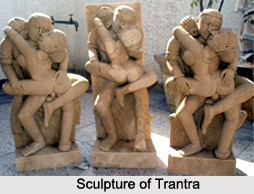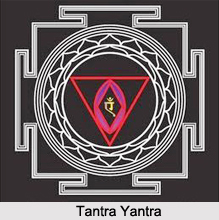 Tantrism has persisted and thrived throughout Asian history since the middle of the first millennium. It deals with spiritual practices and ritual forms of worship aiming at liberation from ignorance and rebirth. The universe is regarded as the godly play of Shakti and Shiva. Tantrism developed into a tradition by the end of the Gupta reign. However it has influenced major religions like Hinduism, Sikhism, Buddhism and Jainism. Tantrism is characterized by the use of rituals thereby identifying macrocosm and microcosm. In Tantrism one uses the heavenly power that flows through the universe to achieve certain goals.
Tantrism has persisted and thrived throughout Asian history since the middle of the first millennium. It deals with spiritual practices and ritual forms of worship aiming at liberation from ignorance and rebirth. The universe is regarded as the godly play of Shakti and Shiva. Tantrism developed into a tradition by the end of the Gupta reign. However it has influenced major religions like Hinduism, Sikhism, Buddhism and Jainism. Tantrism is characterized by the use of rituals thereby identifying macrocosm and microcosm. In Tantrism one uses the heavenly power that flows through the universe to achieve certain goals.
Derivation of Tantrism
The term “Tantra†in Sanskrit means warp or weave. In Hinduism, it means denotes any systematic broadly applicable text, theory, or system. If the word “tantra†is split then "tan" means to extend which can also denote a doctrine. As per colonial European invention, tantra means an esoteric practice or religious ritualism. It implies "interweaving of traditions and teachings as threads into a practice or method. Rigveda mentions Tantra as “weavingâ€. Other ancient texts like “Brahmana†and “Atharvaveda†refers to "tantra" as principal or essential part. Hindu epics and smritis describe "tantra" as a chapter and the word also appears as “atma-tantra†meaning "doctrine or theory of Atman.â€
After 500 BCE, the term "tantra" was given a bibliographic category in Hinduism, Buddhism, and Jainism. “Kamikagama†or “Kamika-tantra†written in 600 BCE defines "tantra" as an extensive knowledge of principles of reality. According to “Harsacharita†by Poet and Sanskrit scholar Banabhtta, "tantra" is a set of rituals or method to word a group of female goddesses. "Tantraloka" by Abhinavagupta explains it as a set of teachings or systems, sometimes called "Agamas." During the 16th century, Philosopher Bhaskararaya refers to "tantra" as a system of thoughts or doctrines.
Origin of Tantrism
Origin of Tantrism is a debatable issue. There are diverse views - some say that the Pre-Aryan Indians could have been the discoverers; others consider it as the tradition of ancient people. Historically it dates back to the time of the rise of the religion of Buddhism as the later Buddhists adopted some of the Tantric symbols.Tantrism, which appears in both Buddhism and Hinduism, influenced many religious movements from the middle of the 1st millennium CE was meant for esoteric circles. In Hinduism, Tantra pervades the theistic traditions of Saivism, Shaktism, and Vaisnavism.
Over a period “tantra†became associated with “Shakti†or the divine creative energy as a method to conquer transcendent powers. It is now considered a part of yogic rituals to achieve supernormal goals.
Purpose of Tantrism
Tantrism is a pursuit for those who want to attain spiritual perfection and magical control. One can achieve complete control of oneself, all the forces of nature to attain union with the cosmos and the divine. One has to go through rigorous training to master these methods. Yoga, Mudras, mantras, words and phrases; Mandalas and yantras, which are symbolic diagrams of the forces at work in the universe, are methods for meditation.
The principles of Tantra initiate new form of application based on Vedas, Upanishads and Bhakti Marg of the Hindu texts. It is a synthesized doctrine approved by all sects. Tantrism is a quest for spiritual perfection and magical power. Prakriti and Purusha are the foundation of Tantrism. Buddhist, Hindu and Jain are the three schools of Tantrism. This classification is done on basis of deities worshipped and rites followed. In Narad Purana seven kinds of Tantras have been mentioned.
Tantra is about arousing energy at a higher level, frequency and velocity. It is about balance; not as an invalidating out of forces, but as a profound union that brings about a higher life, meaning and way of expression. In this Tantric process, different goddesses have their authoritative roles. `Kali" unfolds the transformative forces of time and space, time as the creative flow of transformation and space as the womb or matrix of new energies. The goddess sets one`s sadhana in motion and keeps it going with Her relentless force that is at times almost overmastering.
Rise of Tantrism
According to scholars, pioneers of Tantra have been ascetics who lived at the cremation grounds, and probably were not Brahmins. During the early medieval times, their practices included worshipping mother goddesses like Kali and Bhairava. The worship was mainly about inviting the deities to enter them so they can gain its power. Tantric practices developed in both Buddhist and Brahmanical period. Shaivas and Buddhists borrowed from each other. This led to the gradual transformation of deity cults through which fierce female deities came to take a leading role replacing yaksas.
The period between 8th and 14th century is called “Tantric age†due to a massive rise in tantric traditions throughout Indian subcontinent. During the 10th century, practice of tantric rituals was at its peak. Various tantric texts like Agamas, Samhitas and Tantras were also written and translated into regional languages. Buddhist Tantra was also embraced by the mainstream Mahayana Buddhist during the tantric age. This tradition, in the form of literature also made its way to great universities such as Nalanda and Vikramashila.
Relation to Vedic Tradition
The tradition of Tantrism may be considered as intertwined with the Vedic tradition. The sources of written Tantric tradition are the agama which consists of four parts describing jnana, yoga, kriya and charya. Elements of Tantrism exist in Shaiva, Vaishnava, Ganapatya, Shaurya and Shakta forms. The basic ideas of Tantra as a philosophy are found in the Rig Veda. Tantrism is a build-up of various resources to change mundane into super mundane. There are some hymns and use of mystic words during the Rig Vedic period which proves the origin of Tantra.
Relation to Yoga
Tantra refers to an esoteric yogic tradition that developed on the Indian subcontinent from the middle of the 1st millennium onwards in both Hinduism and Buddhism. Yoga and Tantrism are contrary and they intersect as some philosophies and goals are common. Osho during his discourse on Vijnana Bhairava Tantra differentiate between Yoga and Tantrism by saying, "Yoga is suppression with awareness; tantra is indulgence with awareness.
 Relation to Indian Puranas
Relation to Indian Puranas
In the early stage, we find some of the puranas rejecting Tantra as a practice as it was non Vedic. The Indian Puranas like Agni, Garuda and Padma have Tantric elements initially. The Narada Purana has recorded Tantrism in detail. The portion related to that is called Bhagavata Tantra. It gives a description of Tantric deities and procedures to be followed for the fulfilment of people`s desires and a number of mantras pertaining to those deities. It comprises a direct contact with the Tantric deities and their energies as living powers, both within and around everybody. Tantric practice requires working with the forces of Nature as powers of consciousness, discovering the Shakti or spiritual energy in life behind all that one perceives and experiences.
Relation to Shaktism
Shaktism is the worship of female goddess and Tantrism is the practice or release of the ultimate truth. In Puranas, tantra has been associated with knowledge, philosophy, yoga, and ritual. The philosophy tends to be a syncretistic mixture of Sankhya and Vedanta thought, with special and at times exclusive emphasis on the God"s power, or Shakti. One of the sections of Tantric texts includes Shakta Tantras the others are Vaishnava Samhitas, and Shaiva Agamas.
Relation to Shaiva Agamas
Shaiva Agamas is a vast literature spanning across several centuries. Agamic Shaivas are the worshipper of Lord Shiva who follow their own traditions- Sanskritic Shaiva-siddhanta. According to this doctrine, Shiva is the conscious principle of the universe, while matter is unconscious. Shiva"s power, or shakti, personified as a goddess, is also a magic word. She is sought out and meditated upon in mantras. This Shakti has been associated with tantrism for ages.
Relation to Vaishnava Samhitas
Vaishnava Samhitas comprises of Pancharatra Samhitas and Vaikhanasa Samhitas. The philosophy of Pancharatra Samhitas is largely a matter of cosmogony, greatly inspired by both Sankhya and Yoga teachings. Vaishnava Samhitas considers Lord Krishna as supreme God and he divided himself into four co-equal parts called "vyuhas". These gods emanate as supramundane patrons before the primary creation is started by their Shakti.
Doctrines of Tantrism
The aim of Tantrism is inspirational rather than wiping out the relative reality. The process of sublimation consists of purification, elevation, and the "reaffirmation of identity on the plane of pure consciousness". Dakshinachara methods are different from that of Vamachara. Moreover, Shakti sadhana in Tantric practice implies a whole-hearted veneration of the prowess of Shakti in everyday life. Tantra directs Shakti sadhana in three levels, signifying Dakshinachara, Vamachara and Samayachara. Shakti on the other hand is the manifestation of divine power in one`s body: physical, subtle and casual. Hence the sadhana of Shakti demands absolute belief and perseverance.
Mantras in Tantrism
The mantras or sacred texts and hymns are believed to be indispensable means of entering into contact with the power in tantrism. Mantras constitute the main element of the essence of divine power as the eternal, indestructible prototypes from which anything phenomenal derives its existence. There is Tantric mantra-yoga which operates with hatha-yoga. It incorporates normal Yogic practices such as abstinences, observances, bodily postures, etc. It also consists of internal purifications through different bodily movements.
Tantra discovers the Divinity in life, in the rasas or essences of beauty and feeling that all experiences are seeking.









